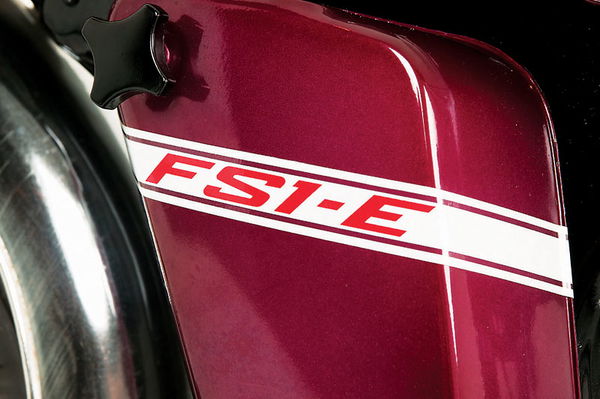Bike Icon: Yamaha FS1-E
It's the bike that was once parked outside chip shops across the land. Here we look at the Fizzie and all of its 4.8bhp. Long live pedal power!


1972 will be remembered for many things. Nixon ordered the development of the Space Shuttle program, Pakistan withdrew from the British Commonwealth and (thank you Lord!) Cameron Diaz was brought into this world.
But the year will also be remembered for a revelation which took place within the motorcycling community; one that would promote chip shop posing and school gate stunts for years to come. If you were a 'yoof' back then, the chances are you loved it too: the Yamaha FS1-E.
It soon became apparent that the 'Fizzie' would endure, and many teenagers still dreamt of owning one 10 years on from its launch. A combination of simple yet effective engineering, cheap and plentiful spares - not to mention the new 1977 moped laws (limiting all 'peds after '77 to 30mph) - would make this so. Oh, and some did about 55mph, which is akin to cracking the ton when you're 16!
The bike was launched as a sports moped and was the first of its kind. Until then, only larger capacity machines were given the go-faster treatment, but Yamaha recognised an entire generation of young bikers had nothing to use but relatively boring transport. Yamaha's plan was to inspire teen 'desire' for a 50cc machine. And it succeeded.
The usual fare was to dutifully ride your Puch Maxi or other 'ped until you could get hold of a bigger bike, and this interim period was a chore to many. When the 'Sixteener Special' FS1-E was revealed and word of its prowess and top speed spread, spotty kids were agog and wanted one - very badly indeed. Job done for Yamaha then. But what made the Fizzie so good and how do you make a learner machine appealing?
For starters, it looked the business - a generation ahead of the other machines of the day. In fact it looked so good, and such was its popularity, that the Suzuki AP50 released a few years later pretty much resembled the Fizzie like for like - right down to the bicycle pedals. That's right, bicycle pedals - and before you laugh, they were compulsory back then (a law negated in '77), not to mention being damn handy if you ran out of fuel!
It's hard to imagine there's actually a piston working in the tiny barrel, but there's a full 49cc being put to work. The two-stroke, rotary valve induction engine produced 4.8bhp at 7000 rpm - more than enough to take the bike through its four gears and up to its 45mph-plus top speed.
The bike was small: only 69 inches long, 22 inches wide, and it weighed in at just 70kg. The chassis and suspension components were of a higher quality than its moped peers, and sophisticated enough to use wholesale on the larger capacity YB100 released later on.
The original 1972 machine was fitted with drum brakes front and rear, but the front was replaced in '75 by a disc system. Unusually, when Yamaha reintroduced the Fizzie in 1987 it reverted to drum brakes again, despite updating other parts of the machine to a more modern specification while retaining the original look. What impressed most was that Yamaha had pulled out all the stops to make the Fizzie appealing from a specification point of view as well as an aesthetic one.
The Fizzie became a hotbed of aftermarket tuning parts. Big-bore kits, whippy exhausts and more were available to the enthusiast. You could even sneak in the engine from the YB100 if you weren't too fussed about getting your collar felt. The beauty of this bike though, was that it could be returned to standard fairly easily and cheaply. This was a bike you could keep going on a shoestring; a fact that added to its longevity and popularity.
There was a time when you couldn't look at a road without seeing a Fizzie buzzing along; they were everywhere, and everybody knew at least one person who owned one. It was a resounding success for Yamaha. Even today, Fizzie mania is still very much with us. There's a thriving online community (www.fs1e.co.uk) as well as organised rallies all helping to rekindle the spark in many a re-born teen. Top stuff. Who said nostalgia wasn't what it used to be?






















